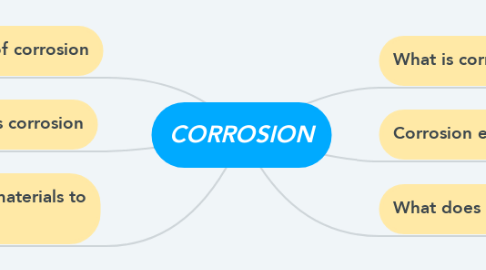
1. What is corrosion?
1.1. Corrosion is the set of chemical and electrochemical phenomena that cause the degradation or destruction of a metallic material by reaction with the surrounding environment.
2. Corrosion elements
2.1. Chemical corrosion consists of a reaction between a metal and a liquid or between a metal and a gas, such as iron, which reacts at certain temperatures with the oxygen present in the atmosphere producing its oxides
2.1.1. high temperatures
2.1.2. a high carbon environment
2.1.3. microorganisms
2.1.4. atmospherich air
2.1.5. low oxigen concetration
2.1.6. impurities
3. Type of corrosion
3.1. pitting corrosion
3.1.1. Pitting corrosion, or pitting, is a form of extremely localized corrosion that leads to the creation of small holes in the metal.
3.2. crevice corrosion
3.2.1. Crevice corrosion refers to corrosion occurring in confined spaces to which the access of the working fluid from the environment is limited.
3.3. galvanic corrosion
3.3.1. Galvanic corrosion is an electrochemical process in which one metal corrodes preferentially when it is in electrical contact with another, in the presence of an electrolyte.
3.4. erosion corrosion
3.4.1. Erosion corrosion is a degradation of material surface due to mechanical action, often by impinging liquid, abrasion by a slurry, particles suspended in fast flowing liquid or gas, bubbles or droplets, cavitation, etc.
3.5. intergranular corrosion
3.5.1. intergranular corrosion is a form of corrosion where the boundaries of crystallites of the material are more susceptible to corrosion than their insides.
3.6. dealloying corrosion
3.6.1. Dealloying is the selective corrosion of one or more components of a solid solution alloy. It is also called parting, selective leaching or selective attack.
3.7. Environmentally assisted cracking corrosion
3.7.1. Environment-assisted cracking occurs due to adverse effects of the environment, predominantly from corrosive environments. It can occur when three factors, stress, material, and environment, are aligned
4. Factors that affects corrosion
4.1. Nature of the metal
4.1.1. More the reactivity of metal, the more will be the possibility of the metal getting corroded.
4.2. Nature of the oxide film that forms
4.3. Moisture
4.3.1. The impurities help in setting up voltaic cells, which increase the speed of corrosion.
4.4. Salt
4.5. Acid
4.6. Temperature
4.7. Presence of electrolytes in water
5. Resistence of materials to corrosion
5.1. Corrosion resistance is the ability to prevent environmental deterioration by chemical or electro-chemical reaction.
5.1.1. there are some metals that are corrosion resistant and require no treatment to acquire this property (However their resistance does not make them 100% immune), for example:
5.1.1.1. low alloy steels
5.1.1.2. alluminium and its alloys
5.1.1.3. stainless steels
5.1.2. the fastest way to protect a metal from corrosion is coated with a protective barrier to prevent it from coming into contact with oxidizing agents. Like:
5.1.2.1. paints
5.1.2.2. sealants
5.1.2.3. electrochemical solutions

